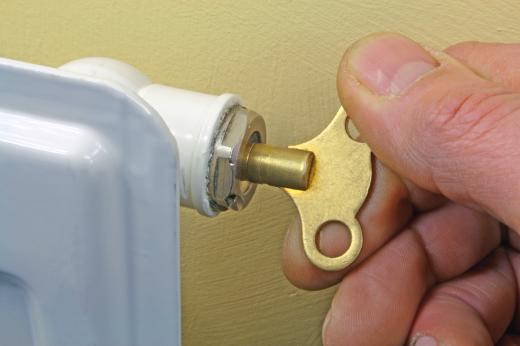An air release valve is a pipe fitting that allows air trapped inside plumbing to escape. Automatic valves that vent whenever air is present in the system are available, along with valves that must be manually operated to vent air. This type of fitting comes in a number of different styles for various applications and can be obtained at a hardware store or through a company that supplies pipe fittings.
Air can build up in plumbing for a number of reasons. It slows the flow rate in the system and can cause a number of other problems with smooth and uninterrupted functioning. Thus, being able to vent air is critically important. There are also safety concerns involved with releasing air, as generally one does not want to release the fluid in the system along with the air. Highly sensitive valves are needed to allow gases out while preventing escape of the fluid.

Automatic valves can be used in any system that contains fluid, whether it is water or another liquid. They are positioned at the highest points in the plumbing. When a system is not pressurized, the air release valve is open, allowing air to move freely out of the air release valve. When the system is pressurized for use, any air it contains will be forced to the highest spots, allowing it to be pushed out of the air release valves. Once fluid starts pushing against the valves, the valves close to prevent fluid leakage.
Manual valves are activated by a human user when there appears to be air in the system. The user can open the air release valve to bleed off air in the system, as seen with the valves on radiators. A system can be fitted with both manual and automatic valves if it is deemed necessary. Some automatic valves may be referred to as degassing valves if they are designed to release air continuously, not just when the system is first pressurized.
The air release valve design limits the amount of air that can escape at any given time and the rating on the valve should be considered when installing it to make sure it meets the needs of the system. Materials used to make an air valve vary, depending on the fluid being carried in the system. If corrosive fluids are in use, for example, the valve needs to be made from materials that will resist corrosion. When designing a plumbing system, care is taken to select appropriate valves for controlling the release of air and maintaining the correct level of pressure inside the system.
Ever since she began contributing to the site several years ago, Mary has embraced the exciting challenge of being a About Mechanics researcher and writer. Mary has a liberal arts degree from Goddard College and spends her free time reading, cooking, and exploring the great outdoors.

